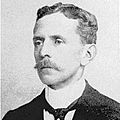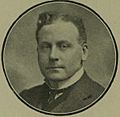West Ham North (UK Parliament constituency) facts for kids
Quick facts for kids {{{Name}}}[[{{{Type}}} constituency]] |
|
|---|---|
| [[Image:{{{Map1}}}Constituency.svg|120px|]] [[Image:England{{{Map2}}}.svg|120px|]] |
|
| {{{Name}}} shown within [[{{{Entity}}}]], and {{{Entity}}} shown within England | |
| Created: | {{{Year}}} |
| MP: | {{{MP}}} |
| Party: | {{{Party}}} |
| Type: | House of Commons |
| County: | [[{{{County}}}]] |
| EP constituency: | [[{{{EP}}} (European Parliament constituency)|{{{EP}}}]] |
West Ham North was an area in the County Borough of West Ham (which is now part of Greater London) that elected a person to represent it in the Parliament of the United Kingdom. This area is called a parliamentary constituency. It sent one person, known as a Member of Parliament (MP), to the House of Commons. The MP was chosen using a voting method called first-past-the-post, which means the candidate with the most votes wins.
Contents
- What Was West Ham North?
- Where Was West Ham North Located?
- Who Represented West Ham North?
- Elections in West Ham North
- 1885 General Election
- 1886 General Election
- 1892 General Election
- 1895 General Election
- 1900 General Election
- 1906 General Election
- January 1910 General Election
- December 1910 General Election
- 1911 West Ham North By-election
- 1950 General Election
- 1951 General Election
- 1955 General Election
- 1959 General Election
- 1964 General Election
- 1966 General Election
- 1970 General Election
- Images for kids
- See also
What Was West Ham North?
West Ham North was a special area set up for elections in the United Kingdom. It was created twice and then removed twice.
When Was West Ham North Used?
The West Ham North constituency was first created in 1885. It was used for the general election that year. However, it was removed before the 1918 general election.
Later, West Ham North was brought back for the 1950 general election. It continued to be used until it was removed again before the February 1974 general election.
Where Was West Ham North Located?
The exact borders of West Ham North changed over time.
West Ham North Boundaries (1885–1918)
When West Ham North was first created in 1885, it was part of a larger area called the parliamentary borough of West Ham. This borough was split into two parts, and West Ham North was the northern part. Its border was defined by railway lines and roads.
For example, the border started where the London and Tilbury Railway crossed the western edge of West Ham Parish. It then followed railway lines and roads like Abbey Road, Church Street North, Portway, and Plashet Lane to the eastern edge of West Ham Parish.
West Ham North Boundaries (1950–1974)
When West Ham North was brought back in 1950, its borders were set by the Representation of the People Act 1948. This time, it included eight specific areas, or wards, within the County Borough of West Ham. These wards were Broadway, Forest Gate, High Street, Newtown, Park, Plashet Road, Upton, and West Ham.
Who Represented West Ham North?
People elected to be a Member of Parliament (MP) for West Ham North were called its representatives.
MPs from 1885 to 1918
Here are the MPs who represented West Ham North during its first period:
- Edward Rider Cook (Liberal Party) was elected in 1885.
- Forrest Fulton (Conservative Party) was elected in 1886.
- Archibald Grove (Liberal Party) was elected in 1892.
- Ernest Gray (Conservative Party) was elected in 1895 and again in 1900.
- Charles Masterman (Liberal Party) was elected in 1906, January 1910, and December 1910.
- Maurice de Forest (Liberal Party) was elected in a special election (by-election) in 1911.
After 1918, the constituency was removed. The areas it covered became part of other constituencies like Stratford and Upton.
MPs from 1950 to 1974
When West Ham North was recreated in 1950, Arthur Lewis (Labour Party) was elected. He remained the MP for West Ham North until the constituency was removed again in 1974.
After 1974, the areas of West Ham North became part of new constituencies: Newham North West and Newham North East.
Elections in West Ham North
People in West Ham North voted in general elections to choose their MP. Here are some of the results:
1885 General Election
- The first election for West Ham North was in 1885.
- Edward Rider Cook from the Liberal Party won with 4,219 votes (54.7%).
- Forrest Fulton from the Conservative Party received 3,500 votes (45.3%).
- Cook won by 719 votes. About 77% of registered voters participated.
1886 General Election
- In 1886, Forrest Fulton (Conservative Party) won with 3,920 votes (55.1%).
- Edward Rider Cook (Liberal Party) received 3,193 votes (44.9%).
- Fulton won by 727 votes. Voter turnout was 70.9%.
1892 General Election
- Archibald Grove (Liberal Party) won in 1892 with 4,976 votes (50.2%).
- Forrest Fulton (Conservative Party) was very close with 4,943 votes (49.8%).
- Grove won by just 33 votes! Voter turnout was 74.4%.
1895 General Election
- Ernest Gray (Conservative Party) won in 1895 with 5,635 votes (53.3%).
- Archibald Grove (Liberal Party) received 4,931 votes (46.7%).
- Gray won by 704 votes. Voter turnout was 73.9%.
1900 General Election
- Ernest Gray (Conservative Party) won again in 1900 with 6,613 votes (61.5%).
- John Bethell (Liberal Party) received 4,133 votes (38.5%).
- Gray won by a large margin of 2,480 votes. Voter turnout was 67.8%.
1906 General Election
- Charles Masterman (Liberal Party) won in 1906 with 6,838 votes (57.3%).
- Ernest Gray (Conservative Party) received 5,094 votes (42.7%).
- Masterman won by 1,744 votes. Voter turnout was 79.0%.
January 1910 General Election
- Charles Masterman (Liberal Party) won again in January 1910 with 7,023 votes (53.4%).
- Ernest Gray (Conservative Party) received 6,133 votes (46.6%).
- Masterman won by 890 votes. Voter turnout was 84.0%.
December 1910 General Election
- Charles Masterman (Liberal Party) won for the third time in December 1910 with 6,657 votes (53.6%).
- Ernest Wild (Conservative Party) received 5,760 votes (46.4%).
- Masterman won by 897 votes. Voter turnout was 79.3%.
1911 West Ham North By-election
- A special election (by-election) was held in 1911.
- Maurice de Forest (Liberal Party) won with 6,807 votes (54.1%).
- Ernest Wild (Conservative Party) received 5,776 votes (45.9%).
- De Forest won by 1,031 votes. Voter turnout was 76.2%.
1950 General Election
- When the constituency was recreated, Arthur Lewis (Labour Party) won with 33,782 votes (68.58%).
- R. M. Prior (Conservative Party) received 12,623 votes (25.63%).
- Richard Leslie Phillips (Liberal Party) received 2,349 votes (4.77%).
- G. W. Dickinson (Christian Democrat) received 503 votes (1.02%).
- Lewis won by 21,159 votes. Voter turnout was 77.83%.
1951 General Election
- Arthur Lewis (Labour Party) won again with 34,156 votes (70.45%).
- James A. Erskine-Shaw (Conservative Party) received 14,328 votes (29.55%).
- Lewis won by 19,828 votes. Voter turnout was 76.57%.
1955 General Election
- Arthur Lewis (Labour Party) won with 27,249 votes (65.89%).
- Muriel Bowen (Conservative Party) received 10,712 votes (25.90%).
- David John Howard Penwarden (Liberal Party) received 3,393 votes (8.20%).
- Lewis won by 16,537 votes. Voter turnout was 67.41%.
1959 General Election
- Arthur Lewis (Labour Party) won with 24,096 votes (59.2%).
- J. Guy Jones (Conservative Party) received 9,318 votes (22.90%).
- David S. Brooke (Liberal Party) received 7,271 votes (17.9%).
- Lewis won by 14,778 votes. Voter turnout was 70.36%.
1964 General Election
- Arthur Lewis (Labour Party) won with 21,228 votes (60.52%).
- Jean Pilkington (Liberal Party) received 7,005 votes (19.97%).
- Christopher Brocklebank-Fowler (Conservative Party) received 6,844 votes (19.51%).
- Lewis won by 14,223 votes. Voter turnout was 62.83%.
1966 General Election
- Arthur Lewis (Labour Party) won with 21,778 votes (65.62%).
- Jean Pilkington (Liberal Party) received 5,882 votes (17.72%).
- William J Shearman (Conservative Party) received 5,527 votes (16.65%).
- Lewis won by 15,896 votes. Voter turnout was 61.83%.
1970 General Election
- Arthur Lewis (Labour Party) won with 17,664 votes (63.17%).
- William J Shearman (Conservative Party) received 7,130 votes (25.50%).
- Brian McCarthy (Liberal Party) received 3,167 votes (11.33%).
- Lewis won by 10,534 votes. Voter turnout was 50.32%.
Images for kids
See also
- West Ham South, another historical constituency in the West Ham area.






